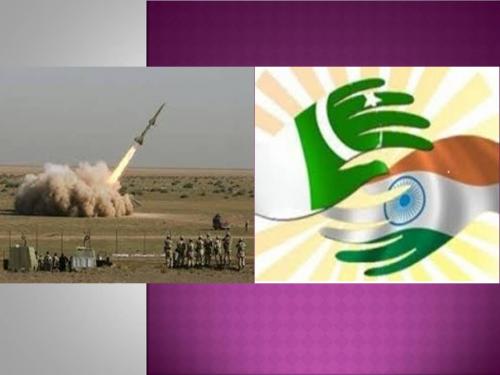
Nuclear weapons might make them super power in the international politics however it gives a huge threat to the entire South Asia. Two regional powers (India and Pakistan) at contemporary global politics probably belong to one of the poorest regions in the world. Distinctly these nuclear nations probably have strong influence in power sharing game in international politics however simply the presence of nuclear bomb in the region itself is a huge threat for the regional peace. Both the countries had declared themselves as a nuclear power in 1998 and gave logic of national security behind developing bomb; India had blamed China’s threat to its national security where as Pakistan blamed to India’s threat. One of them, India has developed the doctrine of no first use of nuclear bomb on the other hand Pakistan has declared it can use the bomb in any point of external threats to the nation.
Whatever logic these countries have the well known fact is they both have nuclear bomb and have been competing in arms race. South Asia is one of the poorest, undeveloped and extremely politically unrest regions in the world. Every year these two nations spend billions of dollars in strengthening military arms and nuclear weapons. Director of Counter proliferation Policy in the Office of the Secretary of
Defence, Mr. Peter R. Lavoy in his paper ‘The Costs of Nuclear Weapons in South Asia’ argues that, it is not easy to calculate the costs or benefits of the Indian and Pakistani nuclear programs. Citing the need for secrecy, New Delhi and Islamabad refuse to reveal what they spend on nuclear weapons or delivery system. Based on likely labour, facility and material costs, however, one can estimate that each state had allocated more than one billion dollar to design and manufacture a small number of nuclear capable missiles (Prithvi and Agni for India and Gauri and Shaheen for Pakistan). According to ‘Global Zero Technical Report, Nuclear Weapons Cost Study’, June 2011, Pakistan spends 2.9 billion dollar annually to develop nuclear weapons. Similarly India spends 4.9 billion dollar annually.
If both these nations had used that money in social development today they wouldn’t have been in the list of poor countries of the poorest region. India and Pakistan are afflicted by some of the world’s worst poverty. Widespread unemployment, outdated infrastructure, rising food prices, and low living standards beset each society. Mr. Lavoy furthers in his paper states, according to one Indian estimate, a single Agni missile costs as much as the annual operation of 13,000 health care centres. More than 3,000 public housing units could be built for the price of one nuclear warhead. The expenditures required to develop India’s ‘minimum’ deterrent could meet twenty five percent of the yearly costs of sending every Indian child to school. Nearly all Pakistani children could be educated and fed for the cost of the nuclear and missile arsenal that is being created for their ‘protection’. In contemporary time national security over shadows the social security of the nation. I observe three key threats of nuclear weapons in the region: competing in arms race to be in ‘nuclear club’ and less importance to the social development, poor confidence building and pilling up mistrusts among the neighbours not only between India and Pakistan but also from non nuclear nations and finally threat of nuclear terrorism to the regional peace.
South Asia is well known in the world for its poverty and politically instable member nations. All the nations in the region have excessive poverty, less GDP, intra conflicts, political unrest, terrorism threat and many more similar problems. However still the member countries are more focused in strengthening military weapons and particularly two big nations: India and Pakistan are first in this race. The provoking message in religious excuse from Pakistan’s foreign chief Zulfikar Ali Bhutto “There is a Christian bomb, a Jewish bomb and now even a Hindu bomb. It’s high time we got a Muslim bomb” is the example of proliferation of nuclear weapons in South Asian region. Despite of knowing the fact that both the countries have so many other social problems to solve which will ultimately establish socio-political stability not merely in their nations but in the entire region, they are highly given priority to military fortification and in race of leading in ‘nuclear club’. If these countries cut up their annual military expenses and exercise that money in domestic infrastructures and social development then they would have been in a position to fulfil the domestic needs and establish sustainable peace in the region.
The enmity between India and Pakistan is deeply rooted since their independence. Doubting each other for every crisis particularly military confrontation and terrorist attacks is their rooted culture. This hostility relation between these two nations was openly resulted in major three wars of 1947, 1965, and 1971 and further fuelled by the declaration of nuclear power from both the countries. Because of having nuclear bomb the level of mistrust between both the nations has gone far above the ground and spying each other have become the priority for each one’s national security. At contemporary South Asian politics the level of mistrust for these two nations is not just limited between them but also expanded to other non nuclear members. The threat to regional peace and amity has emerged because of the presence of nuclear bomb and progressive antagonism between two nuclear powers in the region. Since the nuclear arms are presence in the region the non nuclear nations of South Asia have always been in psychological threat of nuclear attacks. A nuclear conflict between India and Pakistan will have dramatic consequences for the entire South Asia and beyond, because nuclear weapons are weapons of mass destruction and they are not selective. The cost of using a bomb in an Indo-Pakistan conflict would be just a grave for this densely populated region, together with China in the neighbour, driving millions of refugees out of their homes and turning agriculture lands into barren wastes. The presence of nuclear bomb and threats of attack will always be one of the reasons for deficiency of trust between the member nations of South Asia.
Nuclear terrorism is yet another problem not just for south Asia but to the entire world. However south Asia is more vulnerable because of strong presence terrorism in the region. None of the nations of South Asian region are free from conflict either in the form of civil war or intra armed ethnic conflicts. Four nations in the region: Afghanistan, Pakistan, India and Bangladesh are highly vulnerable from terrorist attacks. The rapid increasing presence of terrorism (state and non-state sponsored) in South Asia has become the primary challenge to the regional and global peace process. The well known terrorist organizations like Al-Qaeda, Taliban, LeT (Lashkar-e-Taiba), HIG (Hizib-i-Gullbudin), HuM (Hizb-ul-Mujahiddeen) etc are existed and rooted in South Asia. Here question is what if the key of nuclear weapons is being controlled by the terrorist. The examples of USA attack (11/9/2001), Indian Parliament attack (13/12/ 2001), Mumbai attack (26/11/ 2008), Ahmadiyya Mosque Attack, Lahore (28/05, 2010) etc have highly proved that if the nuclear weapons are controlled by the terrorists they would highly look to create a mass destructions. The immature governing nations like Pakistan and India who are on the other hand nuclear power as well are highly attacked and threatened by these terrorist organizations. Terrorists might not make nuke but they are well expert of how to pit countries and eventually provoke them to an inadequate response. Hence one of the major tasks of these two nations India and Pakistan is to develop enough security for nuclear weapons protection from terrorists.
The nuclear threat to South Asia is not just from its nuclear members but also from its closest neighbour, China. China has huge interest and influence in the South Asian region. At contemporary International Relations, the countries that highly cause concern in South Asian security are India, Pakistan and additionally China. The paradox here is that China has very good relation with one of the nuclear power of the region; Pakistan where as equally have aggressive relations with another nuclear power; India, although the existing relation is indicating harmony through economy and trade. Sino-Pak relation has a long amity history, including their nuclear agenda. India borders on China and Pakistan and is certainly aware of this partnership. India does not have faith in either. The nuclear exercise in the region will not be limited in itself but China would be the first interested because of its geographical proximity, security interest and nuclear weapons commonality. Were a conflict to spark off, it would be trilateral and include not only India and Pakistan but China as well. These three major nuclear powers, two from inside and one from immediate outside the region have been threatening to the regional peace of South Asia and further to the global peace. Being the nuclear weapons holder and most arms developed member nations in the region it is the primary responsibility of both the countries to obtain the principles of NPT (Nuclear Non Proliferation Treaty) and primarily precedence the task of nuclear disarmaments from the region. Nonetheless remaining member nations of the region also have equal responsibility to give pressure to these two nuclear powers to establish regional peace in South Asia through nuclear non proliferations and disarmaments.










Add new comment